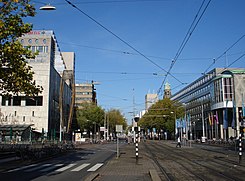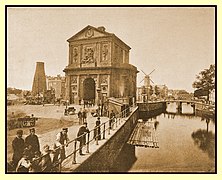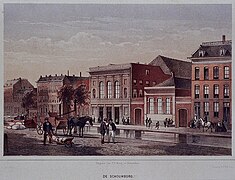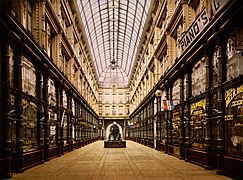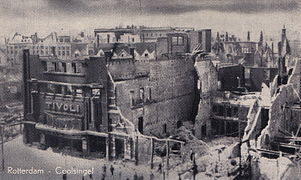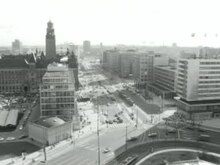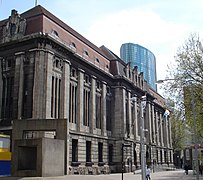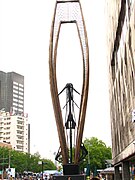Coolsingel
| Coolsingel | |
|---|---|
| Street in Rotterdam | |
| The Coolsingel as seen north from the Churchillplein tram stop | |
| Basic data | |
| place | Rotterdam |
| Hist. Names | Coolvest |
The Coolsingel (formerly: Coolvest) is a main street in the center of Rotterdam on the right bank of the Meuse . Because of its location and spacious open spaces, the street has become a central place for the collective expressions and rituals of urban life. There are important public buildings on the Coolsingel, such as the Rotterdam City Hall and the stock exchange.
history
The street owes its name to the former feudal area Cool, which is mentioned in a document around 1280. In 1596 the city bought the sovereignty of Cool, Blommersdijk and Beukelsdijk from Baron Jacob van Almonde. By royal decree of September 20, 1809, Cool was raised to the status of an independent municipality, but in 1811 it was incorporated into the city of Rotterdam. In addition to the official area, there was also the Polder Cool, which was between the Delfshavener and the Rotterdamsen Schie , but was dissolved in 1925. A part of the area of Cool was integrated into the city as early as 1358 after Duke Albrecht von Bayern had given permission to dig canals around the city and to enlarge the city area into the historical office of Cool. The strip between the two areas was marked by the Coolvest. It formed the western border of the old city triangle. Later this was connected to an already existing fortress ring ( Zingel ). In connection with the construction of a wide road between 1913 and 1922, the canal was completely filled in. As a result, the old name Coolvest also disappeared. The buildings on the Coolsingel were badly damaged by the bombing of Rotterdam by the German Air Force in May 1940. The road was then rebuilt from a functional and economic point of view.
- Coolsingel from a historical perspective
- Historic buildings on the Coolsingel that no longer exist today
The passage around 1890
In the sixties the first subway in the Netherlands was built under the Coolsingel , for which the street was completely closed. Because of the unstable soil conditions, the lowering method was used for the construction . When the excavation pit was flooded, the Coolsingel came a little closer to its original appearance with the waterway for some time. For a year and a half, the city center was divided into two parts by a 1.5 km long canal.
present
Since its reconstruction, the Coolsingel has been the central traffic artery of the city center. It connects the Hofplein with the Blaak. The Rotterdam City Hall as well as the former main post office, the tourist office, de Bijenkorf and a C&A, where the passage used to be, are located on the Coolsingel. In front of the Bijenkorf stands the monument The Stylized Flower (nicknamed The Thing or The Darning Needle ) by Naum Gabo . On the south side, the Coolsingel is completed by the Churchillplein (formerly Van Hogendorpsplein). On the other side, next to the Maritime Museum , you can see the 1940 square, where the famous monument The Destroyed City (nickname Jan Gat) by Ossip Zadkine is located. The World Trade Center (WTC Rotterdam), the business center of Rotterdam, rises on the corner of Beursplein and Coolsingel .
Several RET trams run over the Coolsingel, while the subway runs under the street. Underground, under Churchillplein, the tunnels of the north-south line (lines D and E) and the east-west line (lines A, B and C) of the Rotterdam Metro intersect. The Stadhuis and Beursingel underground stations are also located under the Coolsingel. The Beurstraverse shopping arcade, also popularly known as Koopgoot, runs under the street.
The Coolsingel is the meeting point for large, popular celebrations. Feyenoord championships are usually celebrated on the Coolsingel, and sometimes in the fountain on the Hofplein when the weather is nice. The start and finish of the Rotterdam Marathon and the Rotterdam Summer Carnival also take place on the Coolsingel. It is also the destination of the Roparun , the relay race from Paris to Rotterdam.
Plans to reduce road congestion have been announced for 2016. The refurbishment, which began in 2018, is expected to cost 47 million euros and should be completed by 2020. In the future, cyclists and pedestrians will have more space, and car traffic will be reduced from four lanes (2 in each direction) to two lanes (one in each direction).
- Today's buildings on the Coolsingel
Trivia
In the Dutch version of the board game Monopoly , the Coolsingel is the most expensive street in Rotterdam. It is located where the American version is Pennsylvania Avenue, the British version is Bond Street and the German version is Bahnhofstraße.
literature
German
- Frank Eckhardt: Rotterdam. Contours of a globalized city. Lit-Verlag, Münster 2001, ISBN 3-8258-5483-3 .
Dutch
- Paul van de Laar: Coolsingel: 700 jaar Rotterdammers en hun stad. Bas Lubberhuizen, Amsterdam 2017, ISBN 978-90-5937-506-2 .
Web links
- The website of the street (Dutch)
Individual evidence
- ^ Rob Wentholt: De binnenstadsbeleving en Rotterdam . Ad. Donker, Rotterdam 1968, ISBN 978-1-4709-8847-0 , pp. 134-135 .
- ↑ Johan Cornelis Okkema: De straatnamen van Rotterdam: verklaring van all bestaande en van verdwenen straatnamen. Gemeentelijke Archiefdienst Rotterdam, Rotterdam 1992, ISBN 90-72892-10-0 , p. 94.
- ↑ Louis Frederik Teixeira de Mattos: De waterkeeringen, waterschappen en polders van Zuid-Holland, Volume 2. M. Nijhoff, Den Haag 1908, p. 510.
- ^ Arie van der Schoor: Stad in aanwas: Geschiedenis van Rotterdam dead 1813. Waanders, Zwolle 1999, ISBN 978-90-400-9349-4 , p. 249.
- ↑ Gijsbert van Reyn: Geschiedkundige Beschrijving der stad Rotterdam en got a knocked overzigt van het Hoogheemraadschap van Schieland . Wed. Van der Meer & Verbruggen, Rotterdam 1832, p. 52 .
- ^ Peter Jan Margry, P. Ratsma, BMJ Speet: Stadsplattegronden: werken met kaartmateriaal bij stadshistorisch onderzoek . In: Hollandse Studiën . tape 20 . Uitgeverij Verloren, Hilversum 1987, ISBN 978-90-70403-21-8 , pp. 59 .
- ↑ Han Lörzing: Jaren van verandering: Nederland tussen 1945 and 2014 . 2nd printed edition. Atheneaeum - Polak & van Gennep, Amsterdam 2014, ISBN 978-90-253-0473-7 .
- ^ Jelle Bouwhuis, Jan van Adrichem: Sculpture in Rotterdam. Uitgeverij 010, Rotterdam 2002, ISBN 978-90-6450-482-2 , pp. 138-139.
Coordinates: 51 ° 55 ′ 21.8 " N , 4 ° 28 ′ 43.1" E
